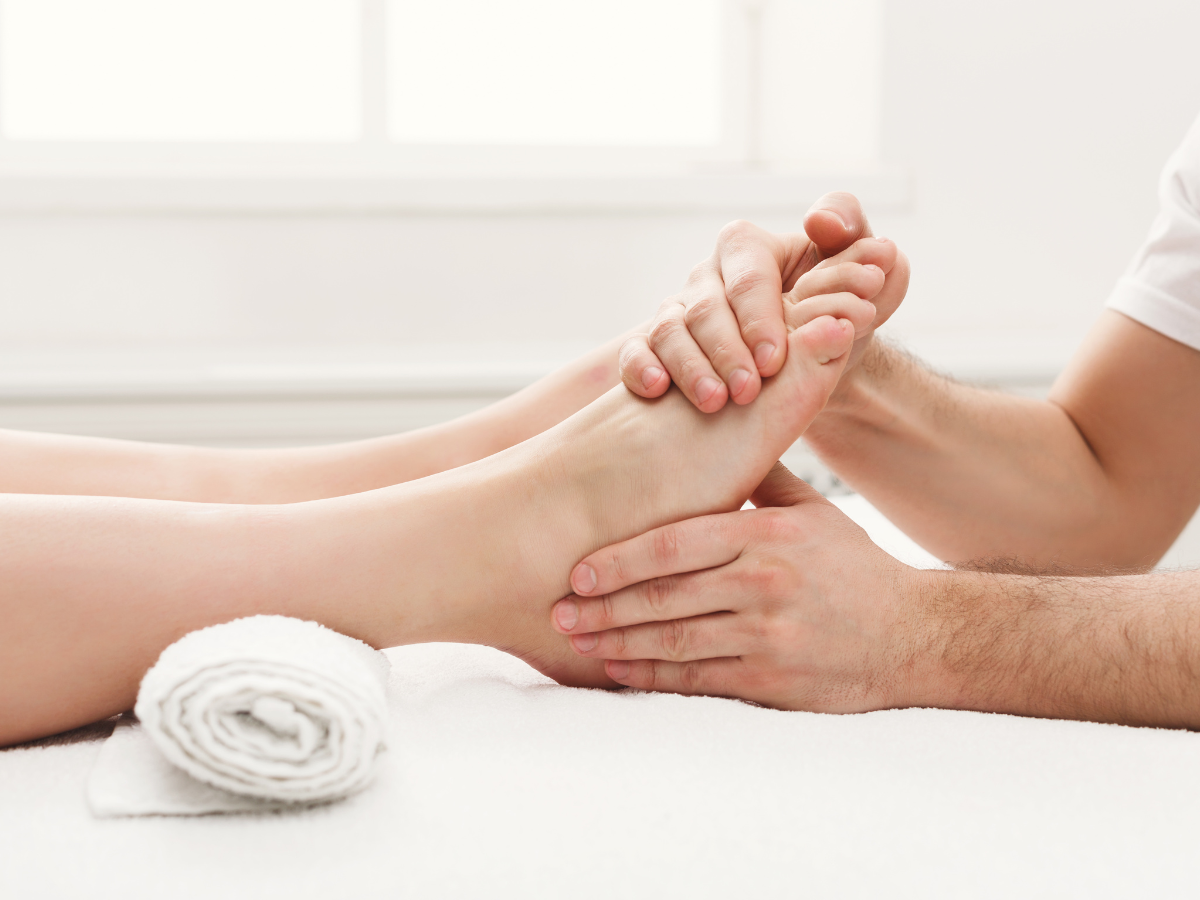Plantar Fasciitis
Understanding Plantar Fasciitis and How Chiropractic Care Can Help
Plantar fasciitis is a common foot condition that affects millions of people every year. It is characterized by sharp pain and discomfort in the heel and sole of the foot, particularly in the morning. While there are many potential causes of plantar fasciitis, such as overuse, obesity, and improper footwear, chiropractic care can be a highly effective form of treatment for this condition. In this post, we will explore the causes and symptoms of plantar fasciitis, as well as the ways in which chiropractic care can help to alleviate pain and discomfort and promote healing.

What is plantar fasciitis?
Plantar Fasciitis is a condition that affects the band of tissue (fascia) that runs along the bottom of your foot and connects your heel bone to your toes. This tissue, known as the plantar fascia, provides support and stability to the arch of your foot, and helps to absorb shock when you walk, run, or jump. When the plantar fascia becomes damaged or irritated, it can lead to inflammation and a sharp, stabbing pain in the heel or sole of the foot, especially when you first step out of bed in the morning.
The factors that contribute to this condition

There are several key factors that contribute to the development of plantar fasciitis, including:
Overuse: One of the most common causes of plantar fasciitis is overuse. Athletes, runners, and people who engage in physical activity on a regular basis can put repeated stress on the plantar fascia, leading to damage and inflammation over time.
Improper footwear: Wearing shoes that do not provide adequate support, or shoes that are worn out, can put unnecessary stress on the plantar fascia and increase the risk of injury. Shoes with insufficient arch support, or shoes that do not provide enough cushioning for the heel, can put undue stress on the plantar fascia and lead to pain and discomfort.
Age: As we age, our feet can become less flexible and lose some of their natural shock-absorbing abilities. This can increase the risk of developing plantar fasciitis, especially if you engage in physical activity or have a sedentary lifestyle.
Obesity: Carrying extra weight can put added strain on the feet, increasing the risk of developing plantar fasciitis. The additional weight can cause the plantar fascia to stretch and become damaged, leading to pain and discomfort.
Flat feet or high arches: People with flat feet or high arches can be more susceptible to plantar fasciitis, as these foot structures can put added stress on the plantar fascia and lead to damage over time.
Certain medical conditions: Certain medical conditions, such as diabetes, rheumatoid arthritis, and lupus, can increase the risk of developing plantar fasciitis. In these cases, the underlying medical condition can cause damage to the tissues in the feet, leading to pain and discomfort.
Sudden increase in physical activity: Starting a new exercise routine or increasing the intensity or duration of your existing routine can put sudden and increased stress on the plantar fascia, leading to damage and pain.
It is important to address the contributing factors of plantar fasciitis in order to effectively manage the condition and prevent future injury. This may include wearing proper footwear with adequate support, losing weight if necessary, stretching and exercising regularly, and reducing the amount of high-impact activity you engage in. To effectively manage the condition and prevent future injury, it is important to address the underlying causes and receive professional medical care.
The symptoms
Understanding the symptoms of plantar fasciitis is important in order to seek proper treatment and prevent further damage.
Heel pain: The most common symptom of plantar fasciitis is heel pain, which is typically sharp and stabbing in nature. The pain is often most intense when taking the first steps in the morning or after sitting for long periods of time. The pain may lessen as you continue to move around, but can return later in the day.
Arch pain: In addition to heel pain, plantar fasciitis can also cause pain and discomfort in the arch of the foot. This pain can be felt as a dull ache and can make it difficult to perform physical activity or wear shoes that do not provide adequate arch support.
Stiffness: The plantar fascia may feel stiff and tight, especially first thing in the morning or after sitting for long periods of time. This can make it difficult to move the foot and perform daily activities.
Swelling: In some cases, plantar fasciitis can cause swelling in the heel or arch of the foot. This swelling can be accompanied by redness and warmth to the touch, indicating inflammation in the affected area.
Limited range of motion: Plantar fasciitis can make it difficult to move the foot and ankle, limiting your range of motion. This can make it difficult to perform daily activities, such as walking, running, or jumping, and can increase the risk of further injury.
Tenderness: The affected area may be tender to the touch, especially when pressing on the heel or arch of the foot. This tenderness can be accompanied by sharp or shooting pain, making it difficult to perform physical activity or wear shoes.
Decreased activity level: People with plantar fasciitis may experience a decreased activity level, as the pain and discomfort can make it difficult to perform physical activity or stand for long periods of time.


Types of treatment for Plantar Fasciitis
While it can be a persistent and difficult condition to treat, there are a variety of different treatments available for those who suffer from plantar fasciitis.
Stretching and Exercise: Stretching and exercise are important components of treatment for plantar fasciitis. Stretching the calf and plantar fascia can help to reduce pain and increase flexibility. Strengthening exercises can also help to support the foot and prevent future episodes of pain.
Physical therapy: Physical therapy can help to reduce pain and improve function in those with plantar fasciitis. Physical therapists may use a variety of techniques, including ultrasound, deep tissue massage, and electrical stimulation, to reduce pain and inflammation in the affected area.
Orthotics: Orthotics, such as shoe inserts, can help to provide additional support to the foot and reduce the strain on the plantar fascia. Custom orthotics can be designed to specifically address the needs of each individual patient, providing optimal support and reducing pain.
Anti-inflammatory medications: Nonsteroidal anti-inflammatory drugs (NSAIDs) can be used to reduce pain and inflammation associated with plantar fasciitis. These medications can be taken orally or applied topically, and can provide These medications can be taken orally or applied topically, and can provide relief from pain and discomfort and discomfort.
Chiropractic care: Chiropractic care can also be an effective treatment for plantar fasciitis. Chiropractors use a variety of techniques, including manual therapy, adjustments, and soft tissue mobilization, to reduce pain and improve function in the foot. Additionally, chiropractors can also help to address any underlying problems in the lower back, hips, or knees that may be contributing to the development of plantar fasciitis.
Chiropractic care can provide a number of benefits for those with plantar fasciitis, including:
- Reducing pain: Chiropractic care can help to reduce pain and discomfort associated with plantar fasciitis. This can help to improve quality of life and make it easier to perform daily activities.
- Improving flexibility: Chiropractic care can help to improve flexibility in the foot, reducing the strain on the plantar fascia and reducing the risk of future episodes of pain.
- Promoting healing: Chiropractic care can help to promote healing in the affected area, reducing inflammation and improving overall function.
- Preventing future injury: Chiropractic care can help to prevent future injury by improving overall function in the foot and addressing any underlying problems that may be contributing to the development of plantar fasciitis.
Chiropractors use a variety of techniques to address the underlying causes of the condition and reduce pain and inflammation, including:
- Manual adjustment: Your chiropractor may perform manual adjustments to the feet, ankles, or lower legs to realign the bones and joints and reduce pressure on the plantar fascia.
- Stretching and exercise: Stretching and exercise can help to improve flexibility and reduce tension in the plantar fascia. Your chiropractor may recommend specific stretches or exercises to help you manage your symptoms.
- Massage: Massaging the affected area can help to reduce pain and promote healing. Your chiropractor may use techniques like soft tissue therapy or trigger point therapy to address any tightness or tension in the muscles and fascia.
- Custom orthotics: If your chiropractor determines that your shoes are not providing adequate support, they may recommend custom orthotics to help redistribute weight and reduce stress on the plantar fascia.

Types of treatment for Plantar Fasciitis
While it can be a persistent and difficult condition to treat, there are a variety of different treatments available for those who suffer from plantar fasciitis.
Stretching and Exercise: Stretching and exercise are important components of treatment for plantar fasciitis. Stretching the calf and plantar fascia can help to reduce pain and increase flexibility. Strengthening exercises can also help to support the foot and prevent future episodes of pain.
Physical therapy: Physical therapy can help to reduce pain and improve function in those with plantar fasciitis. Physical therapists may use a variety of techniques, including ultrasound, deep tissue massage, and electrical stimulation, to reduce pain and inflammation in the affected area.
Orthotics: Orthotics, such as shoe inserts, can help to provide additional support to the foot and reduce the strain on the plantar fascia. Custom orthotics can be designed to specifically address the needs of each individual patient, providing optimal support and reducing pain.
Anti-inflammatory medications: Nonsteroidal anti-inflammatory drugs (NSAIDs) can be used to reduce pain and inflammation associated with plantar fasciitis. These medications can be taken orally or applied topically, and can provide relief from pain and discomfort.
Chiropractic care: Chiropractic care can also be an effective treatment for plantar fasciitis. Chiropractors use a variety of techniques, including manual therapy, adjustments, and soft tissue mobilization, to reduce pain and improve function in the foot. Additionally, chiropractors can also help to address any underlying problems in the lower back, hips, or knees that may be contributing to the development of plantar fasciitis.
Chiropractic care can provide a number of benefits for those with plantar fasciitis, including:
- Reducing pain: Chiropractic care can help to reduce pain and discomfort associated with plantar fasciitis. This can help to improve quality of life and make it easier to perform daily activities.
- Improving flexibility: Chiropractic care can help to improve flexibility in the foot, reducing the strain on the plantar fascia and reducing the risk of future episodes of pain.
- Promoting healing: Chiropractic care can help to promote healing in the affected area, reducing inflammation and improving overall function.
- Preventing future injury: Chiropractic care can help to prevent future injury by improving overall function in the foot and addressing any underlying problems that may be contributing to the development of plantar fasciitis.
Chiropractors use a variety of techniques to address the underlying causes of the condition and reduce pain and inflammation, including:
- Manual adjustment: Your chiropractor may perform manual adjustments to the feet, ankles, or lower legs to realign the bones and joints and reduce pressure on the plantar fascia.
- Stretching and exercise: Stretching and exercise can help to improve flexibility and reduce tension in the plantar fascia. Your chiropractor may recommend specific stretches or exercises to help you manage your symptoms.
- Massage: Massaging the affected area can help to reduce pain and promote healing. Your chiropractor may use techniques like soft tissue therapy or trigger point therapy to address any tightness or tension in the muscles and fascia.
- Custom orthotics: If your chiropractor determines that your shoes are not providing adequate support, they may recommend custom orthotics to help redistribute weight and reduce stress on the plantar fascia.
Conclusion
In conclusion, there are a variety of different treatments available for those who suffer from plantar fasciitis. While stretching, exercise, physical therapy, orthotics, and anti-inflammatory medications can all be effective, chiropractic care can provide a number of additional benefits, including reducing pain, improving flexibility, promoting healing, and preventing future injury. If you are suffering from plantar fasciitis, it is important to seek professional medical care to receive a proper diagnosis and develop an effective treatment plan.
At Integrative Chiropractic, Overland Park, plantar fasciitis can be effectively managed through chiropractic care, physical therapy, and lifestyle modifications. Their chiropractors and physical therapists work together to develop a comprehensive treatment plan for their patients, incorporating various techniques and modalities to reduce pain, improve mobility, and restore function. They strive to provide their patients with the best possible care and support and are dedicated to helping them find relief from plantar fasciitis and other foot problems.
Contact them today to schedule a consultation with one of their therapists, who can discuss your specific needs and set up a plan of action tailored to your unique situation.
Testimonials
Happy Patients
“Really appreciated the time spent listening to issues and understanding that everything is connected. Saw great improvement for my back stiffness on the very first visit.”
“I am in shock and awe….. after dealing with chronic hip, shoulder & neck pain for a year, Dr. Ladd was able to find the problem and solution immediately. I felt so much better after the first visit and now I see a light at the end of the tunnel!“
“Couldn’t be more satisfied, Dr. Carston is just FANTASTIC!! Having been to several well known Spine, Hip and Knee Specialists in the past 2 years I the Overland Park and Leawood area, and not having had any reasonable diagnostics and treatment for my problem, to have found Dr. Carlston has been a blessing. I definitely would recommend him eyes closed!“
Ready for pain relief?
If you have pain and have been everywhere else without relief, schedule a visit to see what’s been missing.
